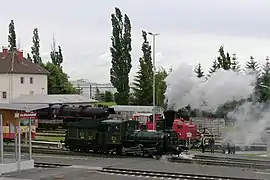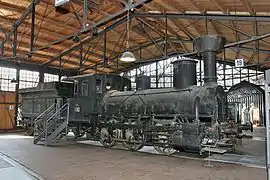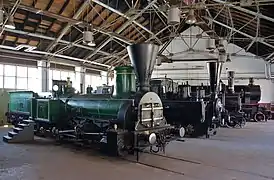Südbahn Class 23 (old)
The steam locomotives of Südbahn Class 23 (old) were goods train engines worked by the Austrian Southern Railway (österreichische Südbahn).
| SB 23 (alt), 29 BBÖ 49 / JDŽ 124 / MÁV 332 / FS 193 ÖBB 153 | |
|---|---|
 GKB 671, ex BBÖ 49.03, ex SB 671 | |
| Wheel arrangement | 0-6-0 |
| Axle arrangement | C n2 |
| Track gauge | 1,435 mm (4 ft 8 1⁄2 in) standard gauge |
| Length over buffers | 14,254 mm (46 ft 9.2 in) |
| Wheelbase | 2,950 mm (9 ft 8 in) |
| Overall wheelbase | 2,950 mm (9 ft 8 in) |
| Wheelbase incl. tender | 9,894 mm (32 ft 5.5 in) |
| Service weight | 38.0 t (37.4 long tons; 41.9 short tons) |
| Adhesive weight | 38.0 t (37.4 long tons; 41.9 short tons) |
| Top speed | 45 km/h (28 mph) |
| Driving wheel diameter | 1,245 mm (4 ft 1.0 in) |
| Cylinder bore | 460 mm (18.11 in) |
| Piston stroke | 632 mm (24.88 in) |
| Boiler Overpressure | 6.75 bar (675 kPa; 97.9 psi) |
| No. of heating tubes | 183 |
| Grate area | 1.59 m2 (17.1 sq ft) |
| Radiative heating area | 8.50 m2 (91.5 sq ft) |
| Evaporative heating area | 113.20 m2 (1,218.5 sq ft) |
| Tender | SB 12 |
| Water capacity | 8.4 m3 (1,800 imp gal; 2,200 US gal) |
| Fuel | 5.4 t (5.3 long tons; 6.0 short tons) coal |
History
The precursors to the Austrian Southern Railway had a very disparate fleet of goods locomotives. The Southern Railway therefore had a six-coupled freight locomotive developed which was based the French Bourbonnais prototype. This series was initially given the designation 23, but was reclassified to 29 in 1864. The Lokomotivfabrik der StEG engine works delivered 20 units in 1860, which proved themselves so well that a total of 205 were built up to 1872 by this factory along with the Wiener Neustädter Lokomotivfabrik and Maschinenfabrik Esslingen.
Modifications
In the course of time there were naturally several modifications: in 1861 to the driver's cab, in the 1880s a vacuum brake with sound absorbers, new boilers, etc...
Dispersal
After nationalisation in 1924 the Federal Railway of Austria (BBÖ) took over 47 units, that were grouped into BBÖ Class 49. After the Second World War a few engines, classified by the Deutsche Reichsbahn as DRG 53.7111–7116, remained in Austria. Of these, the ÖBB only took over number 153.7114 but withdrew her in 1953.
Yugoslavia
Yugoslavia designated the locomotives that it received as JŽ 124.[1]
Hungary
In Hungary they became MÁV 332.
Italy
In Italy they became FS 193.
- Locomotives in FS Class 193
| FS number | New SB number | Builder | Date built | Date scrapped |
|---|---|---|---|---|
| 193.001 | 29.799 | StEg | 1867 | 1928 |
| 193.002 | 29.800 | StEg | 1867 | ? |
| 193.003 | 29.801 | StEg | 1867 | ? |
| 193.004 | 29.802 | StEg | 1867 | ? |
| 193.005 | 29.803 | StEg | 1867 | ? |
| 193.006 | 29.804 | StEg | 1867 | ? |
| 193.007 | 29.806 | Sigl | 1867 | ? |
| 193.008 | 29.811 | Sigl | 1867 | ? |
| 193.009 | 29.812 | Sigl | 1867 | ? |
| 193.010 | 29.813 | Sigl | 1867 | ? |
| 193.011 | 29.784 | StEg | 1866 | ? |
| 193.012 | 29.785 | StEg | 1866 | ? |
| 193.013 | 29.786 | StEg | 1866 | ? |
| 193.014 | 29.787 | StEg | 1866 | ? |
| 193.015 | 29.805 | Sigl | 1867 | 1928 |
| 193.016 | 29.788 | StEg | 1866 | 1928 |
| 193.017 | 29.789 | StEg | 1866 | ? |
| 193.018 | 29.790 | StEg | 1866 | ? |
| 193.019 | 29.791 | StEg | 1866 | 1928 |
| 193.020 | 29.792 | StEg | 1866 | ? |
| 193.021 | 29.793 | StEg | 1866 | ? |
| 193.022 | 29.794 | StEg | 1866 | ? |
| 193.023 | 29.795 | StEg | 1866 | 1928 |
| 193.024 | 29.796 | StEg | 1866 | 1928 |
| 193.025 | 29.797 | StEg | 1866 | 1928 |
| 193.026 | 29.798 | StEg | 1866 | 1928 |
Preservation
Amazingly, five of them are preserved.
During the 1920s the BBÖ sold several engines to the Graz-Köflacher Bahn (GKB). Three of them, built in 1860, were preserved alongside two other Class 23 :
- One of them, number GKB 671, is still working today, albeit with some small modifications such as compressed-air brakes thanks to the work of the Steirischen Eisenbahnfreunde (Styrian Railway Society). Built in 1860, the Austrian-made Südbahn Class 23 (old) locomotive on the Graz-Köflach railway (GKB), is the longest serving steam engine in the world. It is frequently on duty and is used to haul steam specials.
- GKB 674 ex Südbahn 674,[2] has been preserved by the Budapest transport museum and restored with its early roofless drivers cab.
- GKB 680 now belongs to the German Museum of Technology in Berlin.[3]
- Südbahn 718, used by Yugoslav railways, resides in the Slovenian Railway Museum. Built in 1861, was restored with Südbahn livery and an open-top cab.
- Südbahn 852, used by ÖBB until 1958, is awaiting restoration, tenderless, at heizhaus Strasshof.[4][5]
 GKB 671 in 2017.
GKB 671 in 2017. Südbahn 674 in Budapest.
Südbahn 674 in Budapest. GKB 680 in Berlin.
GKB 680 in Berlin. Südbahn 718 in Ljubljana .
Südbahn 718 in Ljubljana ..jpg.webp) Südbahn 859, behind a Kaiserin Elisabeth Bahn locomotive.
Südbahn 859, behind a Kaiserin Elisabeth Bahn locomotive.
References
- "JŽ lokomotiva serije 124", www.miniaturna-zeleznica.com (in Slovenian)
- "Austrian Steam Base". www.dampflok.at. Retrieved 2020-06-29.
- "Austrian Steam Base". www.dampflok.at. Retrieved 2020-06-29.
- https://www.flickr.com/photos/train-pix/13411248715
- "SB 29 852 - Eisenbahnmuseum "Das Heizhaus" Strasshof". eisenbahnmuseum-heizhaus.com. Retrieved 2020-06-29.
Literature
- Dietrich, Herbert (1994). Die Südbahn und ihre Vorläufer. Wien: Bohmann Verlag. ISBN 3-7002-0871-5.
- Schmeiser, Bernhard (1992). Lokomotiven von Haswell, StEG und Mödling 1840–1929. Wien: Nachdruck: Verlag Slezak. ISBN 3-85416-159-X.
- Schröpfer, Heribert (1989). Triebfahrzeuge österreichischer Eisenbahnen - Dampflokomotiven BBÖ und ÖBB. Düsseldorf: alba. ISBN 3-87094-110-3.
- Griebl; Slezak; Sternhart (1985). BBÖ Lokomotiv-Chronik 1923–1938. Verlag Slezak. ISBN 3-85416-026-7.
- Stocklausner, Johann (1979). Dampfbetrieb in Alt-Österreich. Wien: Verlag Slezak. ISBN 3-900134-41-3.
- Tezak, Sepp (September 2003). "Wiederinbetriebnahme 671". Der Fahrtwind. Graz: Steirische Eisenbahnfreunde/Club U44 (50): 3–7.
- Zoubek, Dieter (2004). Erhaltene Dampflokomotiven in und aus Österreich. Eigenverlag. ISBN 3-200-00174-7.
| Wikimedia Commons has media related to Südbahn Class 23. |